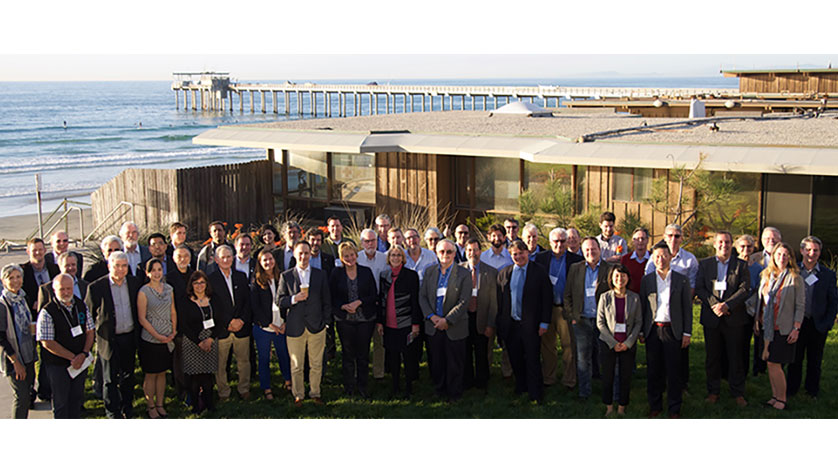Ocean Researchers Showcase Advances in Ocean Observation Technologies

Several dozen of the world’s top oceanographers were at Scripps Institution of Oceanography at the University of California San Diego last week to showcase advances in the technology used to observe the oceans.
At the 19th annual meeting of the Partnership for Observation of the Global Oceans (POGO), which Scripps Oceanography co-founded in 1999, leaders said that the organization has evolved from setting up scientific observation networks in the global oceans to encouraging the spread of oceanographic expertise worldwide. Now, said POGO Chair Karen Wiltshire, the organization seeks to create consensus among scientists to create a global voice calling attention to issues ranging from ocean acidification to deoxygenation and sustainable fishing.
“We’re on a global agenda and not on a continental-scale agenda,” said Wiltshire, vice-director of the Alfred-Wegener-Institut Helmholtz-Zentrum für Polar- und Meeresforschung in Bremerhaven, Germany. “Increasingly we try to help the overall governance of the planet with big statements as to where we should go. It’s one voice and it makes it easier for political leaders to discern what’s important.”
POGO was formed to promote the implementation of international and integrated global ocean observing systems. It is an international network of collaborators and leaders from oceanographic institutions around the world who foster partnerships that advance efficiency in studying and monitoring the world’s oceans on a global scale.
Scripps hosted the first POGO meeting in 1999, when Scripps physical oceanographer Dean Roemmich described an up-and-coming network of robotic floats known as Argo. Nineteen years later, the network has nearly 3,900 floats covering the world’s oceans, making comprehensive measurements of basic variables in the top 2,000 meters (6,500 feet) in each basin for the first time in history. Roemmich was one of several presenters at the meeting to describe the technological progress of Argo, which has deployed 69 new “Deep SOLO” floats capable of diving to 6,000 meters (20,000 feet) to collect data. The transformational program has 26 participating countries and on average, one new research paper using Argo data is published every day.
Despite its successes, the program’s struggle to maintain sufficient funding from its member countries has remained a near constant.
“We need to be both leaner and yet more complete and comprehensive,” Roemmich told colleagues at the Robert Paine Scripps Forum for Science, Society and the Environment. “People might say that’s impossible but I’d turn around and say that’s what people thought about Argo itself when we first started.”
The event also showcased commercial ocean observation products, many of which were conceived for oceanographic or military objectives at places like Scripps. As the technology of robots, gliders, and other platforms has improved, their application has expanded as well to serve what many refer to as the “blue economy” of ocean-related private industry.
Chris Kontoes is a sales representative for RBR Ltd., a maker of sensors and loggers that record fundamental ocean data such as salinity, temperature, pH, and other variables. The POGO meeting, at which he presented products like the coda3 sensor, was his first, but, he said, probably not his last given the outsized role POGO member scientists play in determining institutional and governmental ocean-observing programs.
“I do think knowing those people and having the relationship with them is exceptional for top-down marketing,” Kontoes said. “They’re big influencers.”
“It’s a great group because you have all the directors of the key ocean institutes on the planet in one room at one time,” said Neil Trenaman, a vice president of Poway-based ocean drone manufacturer Ocean Aero, and a member of the Scripps Corporate Alliance. “What I found very good for us was having the opportunity for 10-minute elevator speech conversations. This forum gives you the context to have those discussions.”
The intelligence of the instruments probing the oceans is advancing as well. Scripps oceanographer Jules Jaffe introduced an underwater microscope in 2016 that enabled scientists to view small-scale marine life activity without having to disturb organisms.
At POGO, Jaffe reported on a new chapter in underwater microscopy. To help process the vast data recorded by his microscope, he is experimenting now with giving it enough computing power to employ neural network technology in the field.
“It’s really exciting to think about how this might change our ability to do science,” he told POGO audience members.
POGO-20 takes place Jan. 22-24, 2019 in Mindelo, Cape Verde.
By Robert Monroe

